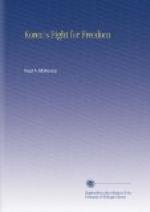Every influence that Mr. Gulick possessed was exercised to prevent premature publicity. The report of the Federal Council was not issued until between four and five months after the atrocities began. A Presbyterian organization, The New Era Movement, issued a stinging report on its own account, a few days before. The report of the Federated Council was preceded by a cablegram from Mr. Hara, the Japanese Premier, declaring that the report of abuses committed by agents of the Japanese Government in Korea had been engaging his most serious attention. “I am fully prepared to look squarely at actual facts.”
The report itself, apart from a brief, strongly pro-Japanese introduction, consisted of a series of statements by missionaries and others in Korea, and was as outspoken and frank as any one could desire. The only regret was that it had not been issued immediately. Here was a situation that called for the pressure of world public opinion. In keeping this back as long as possible Mr. Gulick, I am convinced, did the cause of Korean Christianity a grave injury, and helped to prevent earlier redress being obtained.
“No neutrality for brutality” was the motto adopted by many of the missionaries of Korea. It is a good one for the Churches as a whole. There are times when the open expression of a little honest indignation is better than all the “ecclesiastical statesmanship” that can be employed.
In Japan itself, every effort was made by the authorities to keep back details of what was happening. Mr. Hara, the Progressive Premier, was in none too strong a position. The military party, and the forces of reaction typified by Prince Yamagata, had too much power for him to do as much as he himself perhaps would. He consented to the adoption of still more drastic methods in April, and while redress was promised in certain particular instances, as in the Suigen outrage, there was no desire displayed to meet the situation fully. Taxed in Parliament, he tried to wriggle out of admissions that anything was wrong.
The attitude of the people of Japan at first was frankly disappointing to those who hoped that the anti-militarist party there would really act. One American-Japanese paper, the Japan Advertiser, sent a special correspondent to Korea and his reports were of the utmost value. The Japan Chronicle, the English owned paper at Kobe, was equally outspoken. The Japanese press as a whole had very little to say; it had been officially “requested” not to say anything about Korea.
The Japanese Constitutional Party sent Mr. Konosuke Morya to investigate the situation on the spot. He issued a report declaring that the disturbances were due to the discriminatory treatment of Koreans, complicated and impracticable administrative measures, extreme censorship of public speeches, forcible adoption of the assimilation system, and the spread of the spirit of self-determination. Of the assimilation system he said, “It is a great mistake of colonial policy to attempt to enforce upon the Koreans, with a 2,000-year history, the same spiritual and mental training as the Japanese people.”




